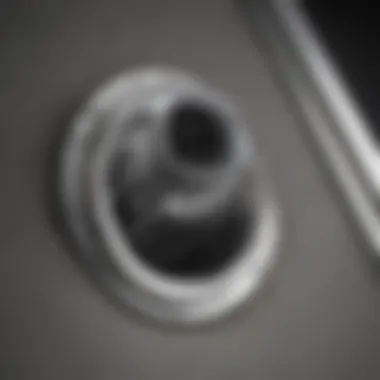Ultimate Exhaust Vent Cleaning Guide for Homeowners


Intro
Cleaning exhaust vents is not merely a chore; it is an essential practice that safeguards your living environment. The buildup of dust, debris, and grease in these vents significantly diminishes their efficiency and can lead to serious health hazards, including reduced air quality and increased fire risks. Regular maintenance can greatly enhance the effectiveness of your ventilation system, ensuring that indoor air remains fresh and safe.
Reflecting on this necessity, we can clearly see how critical it is for both homeowners and maintenance professionals to understand the nuances involved in this cleaning process. This guide will equip you with knowledge of the tools required, provide detailed step-by-step procedures, and highlight safety precautions all aimed at effective maintenance.
Through a thorough examination of these elements, we emphasize best practices and the recommended frequencies for cleaning. Our goal is to ensure that you not only maintain optimal ventilation performance but also cultivate an overall improved living environment. The information provided is structured to be informative but accessible, enabling readers of varied skill levels to approach the task confidently and with clarity.
Prelude to Exhaust Vent Cleaning
Cleaning exhaust vents is a vital aspect of home maintenance that often goes overlooked. These systems play a significant role in maintaining indoor air quality and ensuring safety within the home. Regular cleaning not only prevents the buildup of grease, lint, and dust but also minimizes fire hazards associated with blocked vents. In this section, we will explore exhaust vents, their functions, and the importance of keeping them clean.
Understanding Exhaust Vents
Exhaust vents are designed to expel indoor air, including odors, excess humidity, and airborne pollutants. They are typically found in kitchens, bathrooms, and laundry areas. Each type of vent serves a unique purpose. For example, kitchen exhaust vents carry away cooking fumes, while bathroom vents remove moisture to prevent mold and mildew. By enabling efficient air circulation, these systems improve ventilation, promote comfort, and preserve the integrity of the living environment.
Homeowners should understand their respective exhaust systems to ensure they function properly. A well-maintained exhaust vent will effectively remove stale air and improve freshness in the home. On the other hand, a neglected vent can lead to numerous issues, such as poor air quality and increased risk of fire.
Importance of Regular Cleaning
Neglecting the regular cleaning of exhaust vents can have serious repercussions. Over time, grease and other debris can accumulate inside the vents, reducing airflow and leading to possible blockages. For instance, in kitchen vents, grease buildup can ignite when exposed to heat. This fire hazard underlines the need for diligent cleaning practices.
Moreover, dirty vents can contribute to unpleasant odors lingering in the home. Consistent cleaning significantly enhances air quality by removing trapped pollutants and allergens. This is particularly crucial for homeowners and individuals who suffer from allergies or respiratory issues.
Regular cleaning routines can also prolong the life of your exhaust system. Replacement and repair costs can be exorbitant, thus making preventive maintenance a more economical choice.
"Regular cleaning is essential for maintaining exhaust vents. It not only enhances air quality but also reduces fire risks."
Types of Exhaust Vents
Understanding the different types of exhaust vents is crucial in maintaining optimal indoor air quality and preventing hazards. Each type has unique functions and characteristics, thus necessitating specific cleaning methods and frequency. Proper care for these vents can mitigate risks such as fire hazards and poor ventilation, making it a vital aspect of home maintenance.
Kitchen Exhaust Vents
Kitchen exhaust vents, often referred to as range hoods, play an indispensable role in removing smoke, steam, and odors that arise while cooking. They function by drawing in air, filtering out grease and particulates, and expelling clean air outside. Regular cleaning of kitchen exhaust vents is essential because the accumulation of grease can lead to reduced performance and a heightened risk of fire.
A common type of kitchen exhaust vent is the under-cabinet range hood. These are compact and fit directly underneath cabinets, making them suitable for smaller kitchens. Wall-mounted hoods and island hoods are also prevalent. Each model comes with its own requirements for cleaning, which typically involves removing the filters and scrubbing them with appropriate degreasers.
Bathroom Exhaust Vents
Bathroom exhaust vents help control moisture levels, thereby preventing mold and mildew development in the bathroom. These vents expel humid air after showers or baths, which is critical for maintaining a healthy environment. Failure to clean bathroom vents frequently can lead to clogs, reducing airflow efficiency. This can result in problems like excessive humidity, unpleasant odors, and damage to the bathroom structure over time.
The most prevalent types are ceiling-mounted and wall-mounted fans. Users should ensure that these vents are cleaned regularly to maintain their function, ideally every few months, depending on usage. Simple measures such as dusting the vent cover can go a long way in prolonging its efficacy.
Dryer Vent Systems
Dryer vent systems are vital in expelling hot air and excess moisture from clothes dryers. When lint accumulates in these vents, it not only reduces efficiency but also becomes a significant fire hazard. Statistics indicate that failure to clean dryer vents is a leading cause of dryer-related fires.
The primary cleaning focus should be on both the lint trap and ductwork. It’s advisable to use a dryer vent cleaning kit, which consists of brushes and vacuum attachments that can effectively clear lint buildup. Ensuring that your dryer vents are clean can enhance performance and safeguard against fire hazards.
Essential Tools and Materials
Cleaning exhaust vents requires the right tools and materials to ensure that the process is effective and safe. The importance of having a prepared toolkit cannot be understated. Using appropriate tools leads to more thorough cleaning, minimizes the chance of damage to the vent system, and enhances the overall safety of the task.
Basic Cleaning Tools
The cleaning process often starts with basic tools. These include:


- Screwdrivers (flathead and Phillips): Necessary for disassembling the vent covers.
- Brushes: Different sizes help to reach various parts of the vent. A long-handled brush is useful for getting deep into ductwork.
- Vacuum Cleaner: A powerful vacuum removes accumulated dust and debris quickly. Some models come with specialized attachments for vent cleaning.
- Cloths or Rags: Soft, lint-free rags are ideal for wiping surfaces after cleaning. This ensures that no residue is left behind.
Using these tools can clean surfaces and reach inside ductwork efficiently. This basic toolkit is the foundation of a successful exhaust vent cleaning session.
Chemical Cleaners and Degreasers
For stubborn grime, specially formulated chemical cleaners and degreasers are helpful. These products are designed to break down the grease and built-up residues often found in kitchens and dryers. When selecting chemical cleaners, consider:
- Environmentally Friendly Options: There are products that are biodegradable and less harsh on the environment. Using such options is wise when cleaning vents.
- Non-Toxic Formulations: Prioritizing safety is important. Choosing non-toxic options reduces the risk of inhaling harmful fumes, providing better air quality during and after cleaning.
- Effectiveness: Look for degreasers that specify they are safe for use on metal and compatible with your specific exhaust systems.
Using an appropriate cleaner enhances cleaning efforts and contributes to a safer indoor environment.
Protective Gear
Safety should not be overlooked during these cleaning procedures. Appropriate protective gear shields against the potential hazards associated with using chemical cleaners and working in tight spaces. Key items to consider include:
- Gloves: Rubber or latex gloves protect hands from harsh chemicals and debris.
- Safety Goggles: These safeguard the eyes from splashes of cleaning solutions or dust particles.
- Face Mask: A mask helps to avoid inhaling dust and chemical fumes while working. Choose masks rated for hazardous materials for maximum protection.
Taking the time to gear up properly combines safety with effective cleaning practices. It is a small step that significantly impacts health and safety.
"Investing in proper tools and safety gear is essential for effectively cleaning exhaust vents and safeguarding health."
Armed with the right tools and protective materials, you can approach the task of cleaning your exhaust vents with confidence. The outlined tools and gear not only facilitate cleaner systems but also ensure safety throughout the process.
Step-by-Step Cleaning Procedures
Cleaning exhaust vents is not just a matter of aesthetics; it is crucial for maintaining a safe and healthy living environment. This section outlines a systematic approach to cleaning exhaust vents. By following these steps, homeowners can eliminate dirt, grease, and other particulates that affect ventilation efficiency. A well-executed cleaning process ensures that your exhaust vents function optimally, thereby improving air quality and reducing the risk of fire hazards.
Preparing the Area
Before starting the cleaning process, it is essential to prepare the area adequately. This initial step creates a safe working environment and minimizes disruptions.
- Clear the Space: Remove any objects around the vent to provide unobstructed access. This includes furniture, kitchen appliances, or decorations.
- Protect Surfaces: Lay down tarps or old towels to protect your floor and nearby surfaces from dirt and debris.
- Ventilation: Open windows to increase airflow. This step is especially important when using chemicals.
- Gather Tools: Have all cleaning tools and materials ready, such as a vacuum, cleaning cloths, and chemical cleaners. This reduces the risk of accidents from making multiple trips.
Taking these preparatory steps can greatly influence the effectiveness of the cleaning process.
Disconnecting the Vent
Disconnecting the vent is a critical step. It ensures safety while cleaning and prevents damage to the exhaust mechanism.
- Power Off: Ensure any appliance connected to the vent is turned off and unplugged. This minimizes risk during the cleaning process.
- Use a Screwdriver: Remove any screws or fasteners holding the duct in place. This part may vary depending on the design of your vent system.
- Carefully Detach: Gently pull the duct away from the vent. Take care not to bend or damage the ductwork. If it feels stuck, check for any remaining fasteners.
A careful disconnection protects your systems and makes for easier cleaning later.
Cleaning the Vent Hood
Once the vent is disconnected, focus on cleaning the vent hood. This area often collects grease and grime, which can contribute to poor air quality.
- Apply Cleaner: Spray the vent hood generously with a degreaser. Allow it to sit for a few minutes to break down the grease.
- Wipe Down: Use a soft cloth or sponge to scrub the surface. Pay extra attention to the corners where grease tends to accumulate.
- Rinse: After scrubbing, rinse with water; ensure no cleaning residue remains. This helps to maintain clean air once everything is reassembled.
- Drying: Wipe down the hood with a dry cloth. A clean and dry vent hood aids in better airflow.
This cleaning step is imperative for achieving a fully operative exhaust system.
Scrubbing the Ducts
Ducts can become the main repository for dust, grease, and potentially harmful pathogens. Cleaning them is essential for good airflow.
- Utilize a Vacuum: Use a vacuum cleaner with a hose attachment to remove loose debris from inside the ducts. This initial pass helps eliminate large particles.
- Long-Handled Brush: For stubborn debris, use a long-handled brush designed for ducts. Push the brush into the duct, scrubbing while pulling it out gently. Avoid pushing debris further down.
- Chemical Cleaners: If debris persists, lightly spray with a chemical cleaner. Be cautious and ensure proper ventilation when using them.


Effectively cleaning the ducts ensures better airflow and lessens potential health risks.
Reconnecting and Testing
After cleaning, reconnecting the vent correctly is vital for its function.
- Reconnect the Duct: Align the duct back to the vent hood, ensuring it fits snugly. Check for any gaps.
- Secure Fasteners: Replace any screws or fasteners to hold the duct in place securely.
- Power On: Plug in and power on the appliance connected to the vent. Watch for any irregular noises or vibrations during operation, which may indicate misalignment.
- Check Airflow: Confirm that air is flowing freely through the vent. This step ensures your cleaning efforts were successful.
Testing the reconnected system is crucial for verifying that it operates as intended, allowing for improved air quality in your home.
Safety Precautions
In cleaning exhaust vents, safety should be the paramount consideration. Proper safety precautions can help to prevent injuries, fire hazards, and exposure to harmful chemicals. This is especially relevant for individuals who engage in DIY cleaning or opt to tackle the task themselves without professional help. Understanding the potential dangers and acting accordingly will also ensure a more effective cleaning process.
Fire Hazard Awareness
Fire hazards are a serious concern when dealing with exhaust vents, particularly kitchen and dryer vents. Grease accumulation in kitchen exhausts can ignite if not managed properly. The risk increases if the venting system is not cleaned regularly. Here are some key points to consider:
- Regular Inspection: Inspect your vents periodically for any signs of grease buildup; this can help catch problems early.
- Cleanliness Standards: Adopt a rigorous cleaning schedule to maintain the exhaust vents in a safe condition. For many homes, an annual cleaning is a baseline recommendation.
- Use of Non-Flammable Materials: When cleaning, always opt for non-flammable and effective degreasers. Avoid using flammable rags or materials during the process.
Regular cleaning of exhaust vents not only enhances air quality but also significantly reduces the risk of fire incidents.
Handling Chemicals Safely
When dealing with chemical cleaners and degreasers, safe handling is crucial. Here are essential practices to ensure safety during application:
- Read Labels: Always read labels and material safety data sheets for specific instructions and risks associated with the products you use.
- Use Protective Gear: Gloves, masks, and goggles should be used to protect skin, eyes, and respiratory systems from potential irritation or harm.
- Ventilation: Ensure that the area is well-ventilated while using chemical cleaners to prevent buildup of harmful fumes.
- Disposal Protocols: Follow local regulations for disposal of chemical substances. Never pour leftover toxic cleaners down the sink or toilet as it may contaminate water supply.
By implementing these safety measures, individuals can engage in exhaust vent cleaning with greater confidence and peace of mind. These precautions not only enhance personal safety but also contribute to the overall effectiveness and longevity of the cleaning efforts.
Frequency of Cleaning
Regular maintenance of exhaust vents is crucial for ensuring both safety and efficiency within a home or commercial space. The frequency of cleaning exhaust vents directly impacts indoor air quality, reduces fire hazards, and improves the overall functionality of the ventilation system. Understanding how often to clean is not just about following a schedule; it involves assessing usage patterns, the type of vent system, and the environment in which the system operates.
Clean exhaust vents function more effectively, leading to less energy consumption and a healthier living space. Moreover, neglecting regular cleaning can escalate the accumulation of dust, grease, and other potential obstructions.
"Preventative maintenance is far more effective than reactive measures; understanding frequency can save time and resources in the long run."
General Guidelines
The general guidelines for cleaning exhaust vents depend on several factors. Here are key recommendations to consider:
- Kitchen Exhaust Vents: It is advisable to clean kitchen exhaust vents every three to six months. This frequency helps to minimize grease buildup, which can pose a fire risk.
- Bathroom Exhaust Vents: These should be cleaned at least once a year. Humidity and moisture can lead to mold and mildew if not addressed regularly.
- Dryer Vent Systems: Recommended cleaning frequency for dryer vents is at least once a year. More frequent cleaning may be necessary based on usage.
Homeowners should also look for signs indicating that a vent may need cleaning sooner, such as reduced airflow or unusual odors. Adjustments in frequency can help maintain optimal performance.
Special Considerations for Frequent Users
For those who use exhaust systems more frequently, like in commercial kitchens or during extensive household activities, the cleaning schedule should be adjusted accordingly. Here are some points to consider:
- High-Usage Environments: In settings with substantial cooking or moisture-producing activities, cleaning might need to occur monthly.
- Visual Inspections: Implementing regular visual inspections can be beneficial. If there is a noticeable buildup, cleaning should occur regardless of the previous schedule.
- Seasonal Changes: During specific seasons, such as summer or holiday seasons, when cooking and use are usually more intense, checks on vent functionality should be more diligent.
By adopting a proactive approach and adjusting the frequency based on specific needs, homeowners can significantly enhance the efficiency of their exhaust systems.
Common Problems and Solutions
Understanding common problems that arise with exhaust vents is vital for maintaining an efficient ventilation system. These issues can impact air quality, create unpleasant odors, and pose safety risks. Recognizing and addressing these problems ensures a healthier living environment and prolongs the life of your ventilation system. In this section, we will discuss two prevalent issues: clogging and unpleasant odors. Each problem has specific causes and solutions worth exploring.


Clogging Issues
Clogging in exhaust vents often occurs due to the accumulation of grease, lint, or dust over time. This buildup can restrict airflow, making the system less effective. Kitchen exhaust vents are particularly susceptible to grease buildup due to cooking emissions. A clogged vent can lead to poor indoor air quality and increase the risk of fire hazards.
To prevent clogging, regular cleaning is necessary. Use appropriate tools like a vacuum cleaner with attachments designed for duct cleaning. Alternatively, consider using a brush specifically made for this purpose. When cleaning, ensure thorough attention to the ducts and any filters installed in the exhaust system.
Here are some steps to address clogging issues:
- Inspect the Vent Regularly: Check the vent system periodically for signs of buildup. Look for blocked vents or greasy filters.
- Use a Professional Service: For severe clogs, consulting with a cleaning service specializing in ductwork can be beneficial. They possess tools and expertise to handle tough clogs efficiently.
- Implement Preventive Measures: Consider installing a baffle filter in kitchen vents to minimize grease accumulation from cooking processes.
Taking these actions can enhance airflow and prevent serious problems from developing.
Unpleasant Odors
Unpleasant odors emanating from exhaust vents can be distressing. These odors can stem from various sources, including stagnant air, mold growth, or food particles that might be trapped within a clogged vent. In kitchen setups, burnt food particles or grease tracing can lead to persistent smells. Similarly, bathrooms can harbor mildew or mold due to high humidity levels if exhaust systems are not functioning correctly.
To eliminate odors, it’s essential to identify the source first. Upon identification, cleaning and remediation steps can be taken. Here are effective strategies to resolve unpleasant odors:
- Cleaning the Entire System: Ensure that both the exterior and interior parts of the vent system are cleaned. This includes filters, ducts, and the vent hood to remove any contaminants.
- Utilizing Natural Deodorizing Agents: Baking soda or vinegar can be used to neutralize odors. Place bowls containing these substances near vents to absorb smells effectively.
- Regular Maintenance Checks: Schedule routine checks of the ventilation system to avoid odor accumulation over time.
Regular maintenance not only keeps your exhaust vents functioning effectively but also ensures freshness in your living space.
In summary, addressing common problems like clogging and unpleasant odors can significantly impact overall ventilation efficiency and indoor air quality. These solutions emphasize the importance of routine checks and cleaning procedures. By remaining vigilant and proactive, homeowners can maintain a healthy and pleasant living environment.
Professional Cleaning Services
Cleaning exhaust vents is not always a straightforward task. Certain factors may complicate the process, leading to the necessity for professional cleaning services. By engaging professionals, homeowners can benefit from expertise, advanced tools, and techniques specifically designed for this kind of work.
When to Call Professionals
Recognizing when to involve professionals is critical for maintaining the effectiveness of exhaust ventilation systems. Consider calling a professional when:
- You Notice Poor Airflow: If you observe a decrease in airflow from your exhaust vents, it could indicate a serious blockage.
- Excessive Noise: Strange noises while the ventilation system operates may suggest ongoing issues that require expert attention.
- Accumulation of Grease or Debris: If you see an excessive build-up of grease or grime, especially in kitchen exhaust systems, it is advisable to seek professional help to ensure thorough cleaning.
- Health Concerns: Poor air quality or unpleasant odors can signal underlying problems. Professional cleaning can effectively resolve these issues.
Calling in specialists can minimize potential risks linked with cleaning exhaust systems, such as fire hazards or environmental health risks.
Choosing the Right Service
Finding the right cleaning service for your exhaust vents is crucial. Here are some key factors to consider:
- Experience and Qualifications: Verify that the service has sufficient experience specifically in cleaning exhaust vents. Look for qualified technicians who understand the nuances involved in this process.
- Reputation and Reviews: Seek reviews or testimonials from previous clients. A reputable service often has positive feedback, which suggests reliability and quality of work.
- Service Offerings: Evaluate what services are offered, ensuring they include deep cleaning of all components of the ventilation system, including the ducts, filters, and fans.
- Pricing and Estimates: Request estimates from multiple services to compare pricing. Make sure there are no hidden fees.
It is key to choose a service that aligns with your budget and specific cleaning needs. You should also ensure that the selected company adheres to safety protocols and relevant regulations.
"Engaging professionals can be more than just a necessity. It is a proactive measure that safeguards against future complications."
By keeping these factors in mind, homeowners can make informed decisions in selecting qualified cleaning services for their exhaust vents.
Ending
Cleaning exhaust vents is not just about maintaining aesthetics. It plays a crucial role in ensuring safety and improving air quality in homes. Throughout this article, we have outlined various key components that highlight the importance of this essential maintenance task.
Regular cleaning prevents the buildup of grease, dust, and other debris which can lead to dangerous situations, including fire hazards. Additionally, clean exhaust vents help in maintaining efficient airflow in kitchens, bathrooms, and laundry rooms, leading to healthier indoor environments.
Recap of Key Points
- Significance of regular cleaning: Reduces fire risks and enhances air quality.
- Types of exhaust vents: Kitchen, bathroom, and dryer vents each have unique cleaning requirements.
- Essential tools and materials: Specific tools and chemical cleaners are necessary for effective cleaning.
- Step-by-step cleaning procedures: Following a systematic approach is crucial for thorough maintenance.
- Safety precautions: Awareness and proper handling of chemicals are important to prevent accidents.
- Professional cleaning services: Knowing when to consult professionals can save time and guarantee quality work.
In addition to these points, the article has emphasized the frequency of cleaning needed based on usage. Homeowners should consider how often these vents accumulate debris and schedule cleanings accordingly.
Final Thoughts
Maintaining exhaust vents is an often overlooked yet vital aspect of home care. By regularly cleaning and understanding the functionality of different types of exhaust systems, homeowners can significantly enhance their living spaces. It is not merely a chore; it is an investment in the safety and well-being of everyone in the home. By following the guidelines provided, you can ensure your exhaust vents operate efficiently and effectively for years to come.



